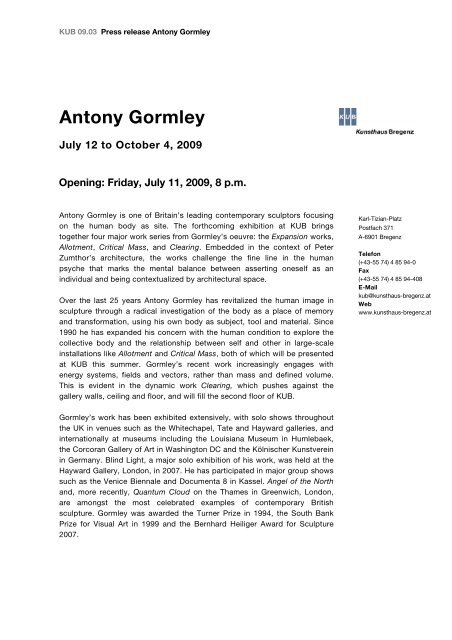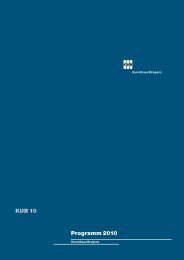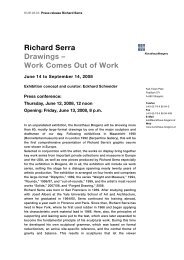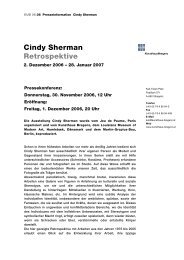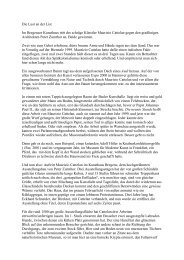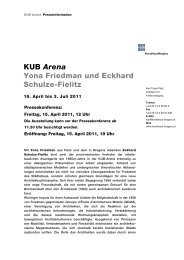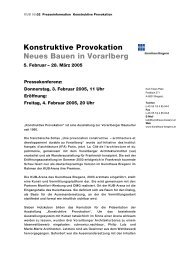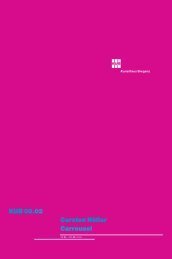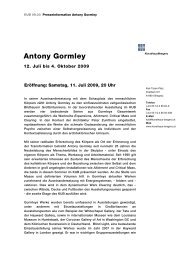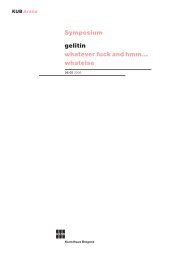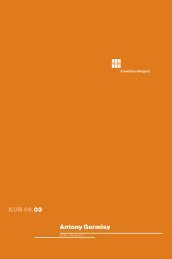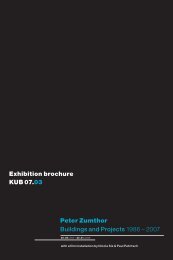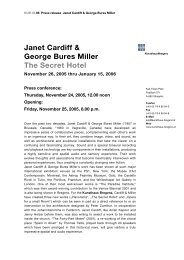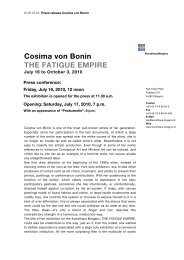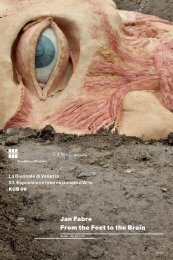You also want an ePaper? Increase the reach of your titles
YUMPU automatically turns print PDFs into web optimized ePapers that Google loves.
KUB 09.03 Press release <strong>Antony</strong> <strong>Gormley</strong><br />
<strong>Antony</strong> <strong>Gormley</strong><br />
July 12 to October 4, 2009<br />
Opening: Friday, July 11, 2009, 8 p.m.<br />
<strong>Antony</strong> <strong>Gormley</strong> is one of Britain’s leading contemporary sculptors focusing<br />
on the human body as site. The forthcoming exhibition at KUB brings<br />
together four major work series from <strong>Gormley</strong>’s oeuvre: the Expansion works,<br />
Allotment, Critical Mass, and Clearing. Embedded in the context of Peter<br />
Zumthor’s architecture, the works challenge the fine line in the human<br />
psyche that marks the mental balance between asserting oneself as an<br />
individual and being contextualized by architectural space.<br />
Over the last 25 years <strong>Antony</strong> <strong>Gormley</strong> has revitalized the human image in<br />
sculpture through a radical investigation of the body as a place of memory<br />
and transformation, using his own body as subject, tool and material. Since<br />
1990 he has expanded his concern with the human condition to explore the<br />
collective body and the relationship between self and other in large-scale<br />
installations like Allotment and Critical Mass, both of which will be presented<br />
at KUB this summer. <strong>Gormley</strong>’s recent work increasingly engages with<br />
energy systems, fields and vectors, rather than mass and defined volume.<br />
This is evident in the dynamic work Clearing, which pushes against the<br />
gallery walls, ceiling and floor, and will fill the second floor of KUB.<br />
<strong>Gormley</strong>’s work has been exhibited extensively, with solo shows throughout<br />
the UK in venues such as the Whitechapel, Tate and Hayward galleries, and<br />
internationally at museums including the Louisiana Museum in Humlebaek,<br />
the Corcoran Gallery of Art in Washington DC and the Kölnischer Kunstverein<br />
in Germany. Blind Light, a major solo exhibition of his work, was held at the<br />
Hayward Gallery, London, in 2007. He has participated in major group shows<br />
such as the Venice Biennale and Documenta 8 in Kassel. Angel of the North<br />
and, more recently, Quantum Cloud on the Thames in Greenwich, London,<br />
are amongst the most celebrated examples of contemporary British<br />
sculpture. <strong>Gormley</strong> was awarded the Turner Prize in 1994, the South Bank<br />
Prize for Visual Art in 1999 and the Bernhard Heiliger Award for Sculpture<br />
2007.<br />
Karl-Tizian-Platz<br />
Postfach 371<br />
A-6901 <strong>Bregenz</strong><br />
Telefon<br />
(+43-55 74) 4 85 94-0<br />
Fax<br />
(+43-55 74) 4 85 94-408<br />
E-Mail<br />
kub@kunsthaus-bregenz.at<br />
Web<br />
www.kunsthaus-bregenz.at
2/5<br />
KUB 09.03 Press release <strong>Antony</strong> <strong>Gormley</strong><br />
KUB Arena:<br />
Body (Cast iron, 1991/93, 6t.), Fruit (Cast iron, 1991/93, 1.25t.)<br />
<strong>Gormley</strong>´s Expansion works began with an obsession with renegotiating the<br />
skin: questioning where things and events begin and end. All forms become<br />
egg-shaped if their skin is repeated, achieving an equilibrium between stasis<br />
and potential. The Expansion works apply this process to the body in<br />
dynamic motion, moving bodies either in self-locomotion or in positions<br />
where the body is the subject of movement. Body and Fruit are derived from<br />
a body-mold in a clasped diving position. To quote <strong>Gormley</strong>:<br />
“I discovered that it was possible to extend the form through the application<br />
of a consistent measure by using wooden spars radiating from nodal points<br />
at the extremities of the body. They were linked together at their outer ends<br />
to form a continuous surface where the feet, hands, buttocks and head<br />
become the foci of a number of domed forms that coalesce.”<br />
1 st Floor:<br />
Allotment II (1996, reinforced concrete, 300 life-size elements derived from<br />
the dimensions of local inhabitants of Malmö aged 1.5 - 80 years)<br />
The measurements of 300 local people of Malmö, Sweden were used to<br />
construct 300 five-centimeter-thick rectangular concrete body cases, with<br />
integrated rectangular head cases, and apertures at the mouth, ears, anus<br />
and genitals. The "rooms" of Allotment are the minimum space necessary to<br />
accommodate a particular living individual, which substitute the second body<br />
(that of architecture) for the first. They are vertical meditation cells for the<br />
absent bodies of a real community. With the pieces laid on a grid path<br />
system the composite work evokes a surrogate cityscape. Some are closely<br />
packed next to each other, some less so. The viewer, having apprehended<br />
the work initially as a whole, will then be able to make his/her way through<br />
the composition, engaging with pieces intimately.<br />
2 nd Floor:<br />
Clearing V (2009, aluminum rod)<br />
Clearing consists of up to 12 kilometers of raw metal rod that arc from floor<br />
to ceiling and wall to wall, creating a three-dimensional drawing in space.<br />
The installation acts as a vector field, encouraging the viewer to move<br />
through its structure, and in so doing disrupts the authority of a single-point<br />
perspective, necessitating instead a constant renegotiation of the visual field:<br />
“I was trying to destroy the fixed co-ordinates of a room and make a<br />
space/time continuum (a line without end) that was both a thing and a<br />
drawing,” says <strong>Gormley</strong>.
3/5<br />
KUB 09.03 Press release <strong>Antony</strong> <strong>Gormley</strong><br />
3 rd Floor:<br />
Critical Mass (1995, cast iron)<br />
Critical Mass is made up of 5 casts of 12 positions: ground-hugging,<br />
crouching, fetal, squatting, sitting, kneeling, standing, mourning and a final<br />
instability - an ascent of man ranging through the complex syntax of the<br />
body. The bodyforms were cast from the outside of a plaster mold and all the<br />
imperfections of the mold surface are reproduced on the finished work, as<br />
are the signs of the loose pieces in the sand mold, the flash lines that exist<br />
between them, and the out-runners of the metal-pouring which are integrated<br />
into the surface, declaring their industrial birth. The work is an antimonument<br />
evoking the victims of the twentieth century. It also communicates<br />
the useless status of sculpture itself. Critical Mass was made in direct<br />
response to a specific building, the Remise, an old tram storage station in<br />
Vienna. The work continues to activate and destabilize the architectural<br />
contexts in which it is presented.
4/5<br />
KUB 09.03 Press release <strong>Antony</strong> <strong>Gormley</strong><br />
Partners and Sponsors<br />
The <strong>Kunsthaus</strong> <strong>Bregenz</strong> would like to thank its partners for their generous<br />
financial support and the cultural commitment that goes along with it.<br />
Presenting<br />
sponsor<br />
Main sponsor<br />
of the <strong>Kunsthaus</strong> <strong>Bregenz</strong><br />
Cultural bodies<br />
Hypo Landesbank<br />
Vorarlberg<br />
Sponsor of the<br />
KUB Arena<br />
Kulturhäuser Betriebsgesellschaft<br />
mbH<br />
With kind support from<br />
Gesellschaft der<br />
Freunde des<br />
<strong>Kunsthaus</strong> <strong>Bregenz</strong>
5/5<br />
KUB 09.03 Press release <strong>Antony</strong> <strong>Gormley</strong><br />
<strong>Kunsthaus</strong> <strong>Bregenz</strong><br />
Venue/Organizer:<br />
<strong>Kunsthaus</strong> <strong>Bregenz</strong><br />
Karl Tizian Platz<br />
A-6900 <strong>Bregenz</strong><br />
Artistic consultant:<br />
Eckhard Schneider<br />
Chief executive:<br />
Artur Vonblon<br />
Curator:<br />
Rudolf Sagmeister<br />
Press and public relations:<br />
Birgit Albers<br />
Phone: (+43-55 74) 4 85 94-413<br />
Fax: (+43-55 74) 4 85 94-408<br />
b.albers@kunsthaus-bregenz.at<br />
Press photos to download:<br />
www.kunsthaus-bregenz.at<br />
Art Education:<br />
Winfried Nußbaummüller<br />
Phone: (+43-55 74) 4 85 94-417<br />
Fax: (+43-55 74) 4 85 94-408<br />
w.nussbaummueller@kunsthausbregenz.at<br />
Publications:<br />
Katrin Wiethege<br />
Phone: (+43-55 74) 4 85 94-416<br />
Fax: (+43-55 74) 4 85 94-408<br />
k.wiethege@kunsthaus-bregenz.at<br />
Editions:<br />
Caroline Schneider<br />
Phone: (+43-55 74) 4 85 94-444<br />
Fax: (+43-55 74) 4 85 94-408<br />
c.schneider@kunsthaus-bregenz.at<br />
Opening hours:<br />
Tuesday – Sunday 10 a.m. – 6 p.m.<br />
Thursday 10 a.m. – 9 p.m.<br />
July 12 until August 23, 2009,<br />
daily 10 a.m. – 8 a.m.


